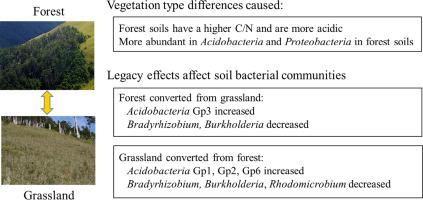Catena ( IF 5.4 ) Pub Date : 2021-02-13 , DOI: 10.1016/j.catena.2021.105205 Yu-Te Lin , William B. Whitman , David C. Coleman , Shih-Hao Jien , Hsueh-Ching Wang , Chih-Yu Chiu

|
As a temperature-sensitive transition zone, the subtropical alpine region responds quickly to global warming. However, little is known about soil microbial communities at the treeline, where changes in vegetation in response to global warming are anticipated. Barcoded pyrosequencing of the 16S rRNA gene was used to investigate the bacterial communities of coniferous forest and grassland soils at the treeline of four different peaks above 3,000 m a.s.l. Although the forest soils were more acidic than the grassland soils, the other soil properties were highly variable with no consistent pattern in C and N contents and microbial biomass between two vegetation types. The Acidobacteria and α-Proteobacteria were the most abundant phylogenetic groups, although their relative abundances differed among the forest and grassland soil communities and between sites. The composition of bacterial communities or β-diversity, varied significantly between the sites and vegetation types. In contrast, α-diversity only differed significantly between sites. Two of the grassland sites and one forest had converted from forests and grassland, respectively within the last 60 years. The abundances of some genera, such as Acidobacteria Gp2 in the grasslands converted from forests, more closely resembled those of the other forest sites than the historically grassland sites, while the abundance of Acidobacteria Gp1 in the forest converted from grassland was more similar to the historically grassland sites. These results suggest a legacy effect for the transition of forest to grassland. Bacterial community structure also correlated significantly with soil pH, organic C and C/N. These results suggest that the present vegetation at the treeline influences soil bacterial community structure, although there is also a significant legacy effect on the abundance of certain bacterial groups.
中文翻译:

亚热带高寒地区林木中的土壤细菌群落
作为对温度敏感的过渡带,亚热带高山地区对全球变暖做出了快速反应。然而,人们对树线的土壤微生物群落知之甚少,据预计,由于全球变暖,植被的变化。使用16S rRNA基因的条形码焦磷酸测序来研究针叶林和草地土壤在3,000 m asl以上的四个不同峰的树线处的细菌群落。尽管森林土壤比草地土壤酸性更高,但其他土壤性质却变化很大两种植被类型之间的碳和氮含量以及微生物量均无一致规律。该酸杆菌门和α-变形菌是最丰富的系统发育群体,尽管它们的相对丰度在森林和草原土壤群落之间以及站点之间有所不同。细菌群落或β多样性的组成在部位和植被类型之间显着不同。相反,α-多样性仅在位点之间显着不同。在过去的60年中,其中两个草地场和一个森林分别从森林和草地转变而来。某些属的丰度,例如从森林转换而来的草地中的酸性细菌Gp2,比历史上的草原位置更类似于其他森林地点,而酸性细菌的丰度从草原转换而来的森林中的Gp1与历史上的草原地点更为相似。这些结果表明了森林向草地过渡的遗留效应。细菌群落结构也与土壤pH,有机碳和碳/氮显着相关。这些结果表明,虽然对某些细菌种群的数量也有显着的遗留影响,但树线目前的植被影响着土壤细菌群落结构。










































 京公网安备 11010802027423号
京公网安备 11010802027423号